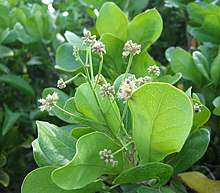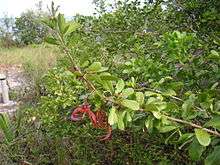Pithecellobium keyense
Pithecellobium keyense, commonly called Florida Keys blackbead,[1] is a species of flowering plant in the legume family (Fabaceae). It is native to the West Indies of North America, where it found in The Bahamas, Belize, Cuba, the Mexican states of Quintana Roo and Yucatan, and the U.S. state of Florida.[2] It typically grows over sand and limestone substrates, often near coastal areas.[3][4] It is a common species throughout much of its range.[3][4]
| Pithecellobium keyense | |
|---|---|
 | |
| Showing emerging flowers | |
| Scientific classification | |
| Kingdom: | Plantae |
| Clade: | Tracheophytes |
| Clade: | Angiosperms |
| Clade: | Eudicots |
| Clade: | Rosids |
| Order: | Fabales |
| Family: | Fabaceae |
| Subfamily: | Caesalpinioideae |
| Genus: | Pithecellobium |
| Species: | P. keyense |
| Binomial name | |
| Pithecellobium keyense Britton ex Britton & Rose | |
Pithecellobium keyense is a shrub or small tree. It has pinnately compound leaves, with 2-4 leaflets. The leaves are evergreen and leathery in texture. Flowers are produced in heads, and range in color from white to pink. Its fruits are a long coiled bean.[3]
 A fruiting specimen
A fruiting specimen
References
- "Pithecellobium keyense". Natural Resources Conservation Service PLANTS Database. USDA. Retrieved 29 July 2018.
- Grandtner, M.M. (2005). Elsevier's Dictionary of Trees: Volume 1: North America. Elsevier Science. p. 671.
- Pithecellobium keyense Leon Levy Native Plant Preserve
- Florida Keys blackbead The Institute for Regional Conservation
This article is issued from Wikipedia. The text is licensed under Creative Commons - Attribution - Sharealike. Additional terms may apply for the media files.